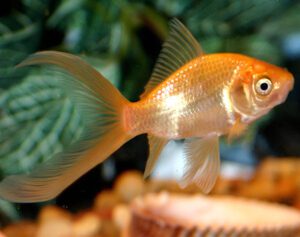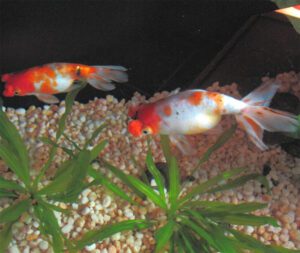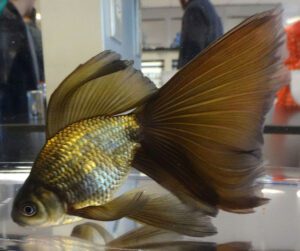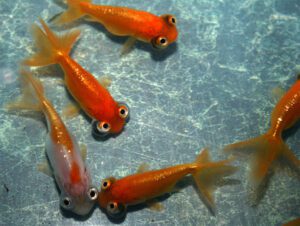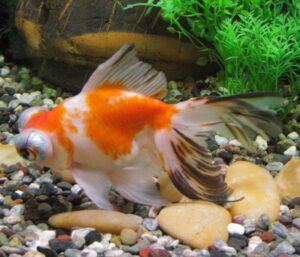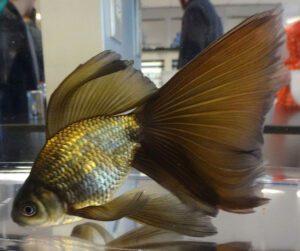The Pearlscale goldfish is a fancy goldfish variety. It is a spherical-bodied fish and also known as Chinshurin in Japanese. It is one of the most recent additions to the fancy goldfish family and was originated in the early 1900s. The Pearlscale goldfish are similar in appearance to the Fantail goldfish at first glance. But actually their body shape is a bit different.
They are the only goldfish variety to have scales with a different shape than the common goldfish variety. The Pearlscale goldfish are extremely hardy fish. They are able to live at colder temperatures, and are ideal for outdoor ponds. Read some more information about this goldfish variety below.
Pearlscale Goldfish Characteristics
The main characteristic feature of the Pearlscale goldfish is it’s thick, domed scales with pearl-like appearance. Body of these fish is round and is similar to a golf ball, and the finnage may be long or short. Their dorsal fin is single, but all other fins are paired. The caudal fin is divided and forked, and held above the horizontal.
The Pearlscale goldfish should be bright and alert and displaying well developed domed scales all over the body area. Their body should be short and rounded, and not elongated. Their caudal fin should be held high without signs of dropping and is well divided. And good quality Pearlscales will have high color intensity extending into the fins.
Pearlscale goldfish are available and found in all kinds of colors. Their common coloration are blue, black, calico, yellow, chocolate, red-and-white, red and orange. Also may be in full black color. But the Crown Pearlscale goldfish is the most popular variation which develops a hood or head growth similar to the Oranda goldfish.
The color may be metallic (self-colored or variegated in a pleasing pattern and similar on each side), orange or calico. Metallic colors should appear as burnished metal, extending into the fins. Calico fish should have a blue background with patches of violet, red, orange, yellow and brown, spotted with black. Mature Pearlscale goldfish generally reach around 4 inches body length, but they can also reach as much as 6 inches. Photo and info from Animal-World and Wikipedia.

Diet
Like many other common or fancy goldfish varieties, the Pearlscale goldfish are also omnivorous. They generally eat all kinds of fresh, frozen and flake foods.
Breeding
The Pearlscale goldfish are egg layers and they spawn readily in the right conditions. They can be bred in groups as small as 5 fish, but likely to breed in large groups as well as they are very social fish. It might be advisable to employ the hand spawning method with this goldfish variety, mainly due to their delicate scales and the risk of injury during natural spawning. Generally a mature female can produce up to 10,000 eggs per spawning.
Uses
The Pearlscale goldfish are among the very beautiful goldfish varieties. They are raised mainly for ornamental purpose. But also good for raising as pets.
Special Notes
The Pearlscale goldfish are extremely hardy fish. They are able to survive in both aquariums and ponds. They are able to live at colder temperatures, and are ideal for outdoor ponds. As they are egg shaped fish with internal organs crowding the their compact body, so overfeeding should be avoided.
The Pearlscale goldfish are generally very sensitive to cold water temperature and should not be exposed to temperature readings bellow 13 °C. They are also quite vulnerable to pH changes and should not be exposed for long periods to a high acidity or alkalinity environment.
The Pearlscale goldfish are generally very social and friendly in nature. They require medium care, and also good for beginners. Their average lifespan is between 10 and 15 years. However, review full breed profile of these fish in the following table.
| Name | Pearlscale Goldfish |
| Other Names | Also known as Chinshurin in Japanese |
| Breed Purpose | Ornamental, pet |
| Special Notes | Very beautiful, attractive appearance, extremely hardy fish, able to survive in both aquariums and ponds, very social and friendly in nature, require medium care, good for beginners, 10-15 years of average lifespan, raised mainly for ornamental purpose |
| Size | Between 4 and 6 inches |
| Breeding Method | Artificial and natural |
| Climate Tolerance | Almost all climates |
| Body Color | Common coloration are blue, black, calico, yellow, chocolate, red-and-white, red and orange |
| Rarity | Common |
| Availability | Worldwide |

